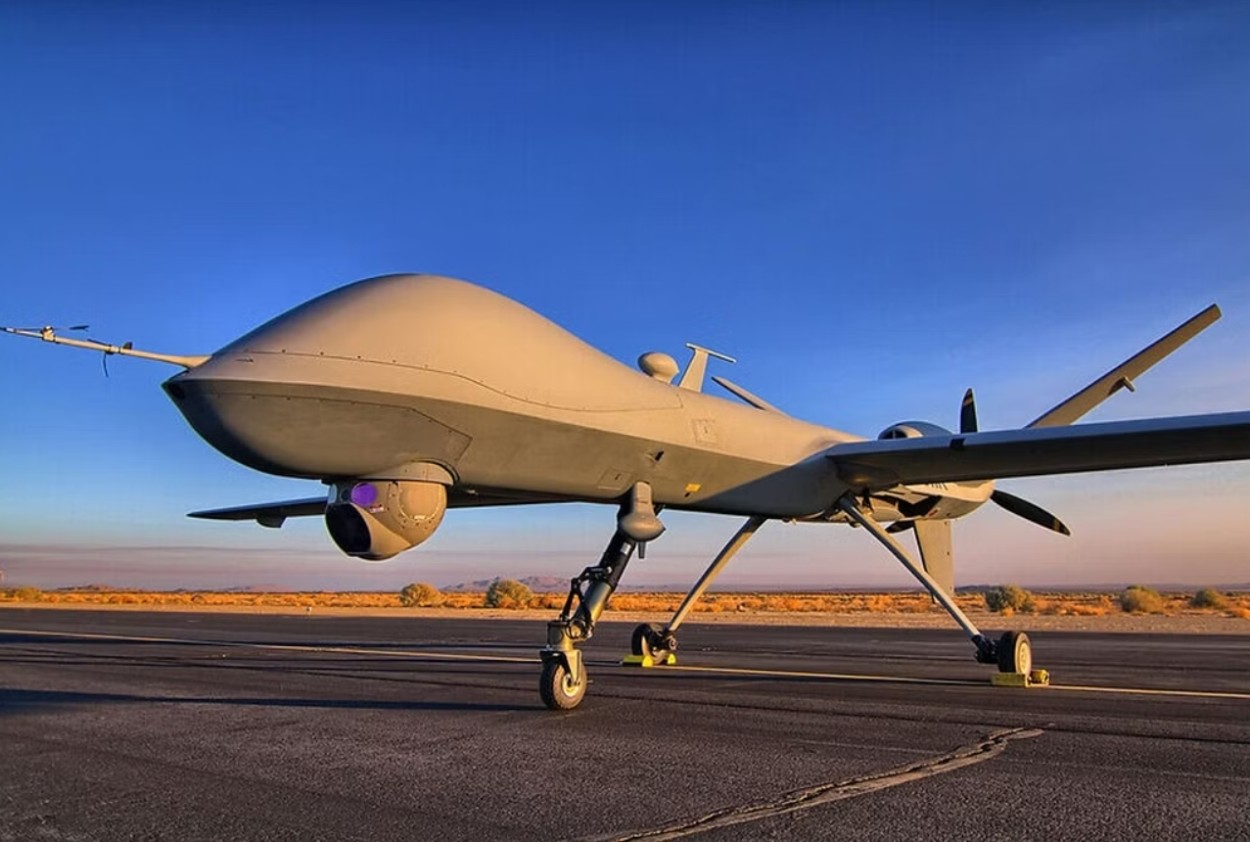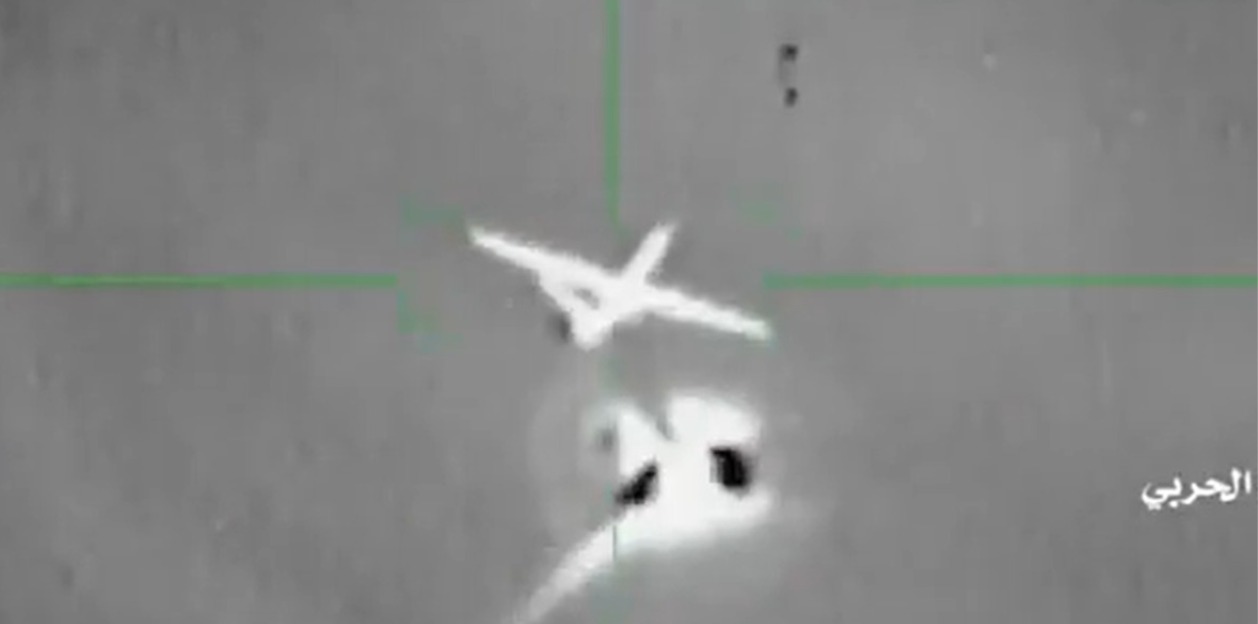In June 2020, the Indian and Chinese troops came to blows at the frigid and inhospitable terrain of the lofty Himalayas. In the ensuing standoff between the two Asian giants following the bloody Galwan clash, a remotely piloted ‘hunter-killer’ of the Indian Navy — MQ-9B — took off from its home base. It traversed thousands of kilometers to give a real-time battle picture to the Indian troops holding ground at those treacherous heights.
The Indian Navy flew land missions along the Line of Actual Control (LAC) at the request of the Indian Army, and these missions cemented the reputation of the MQ-9Bs for the Indian armed forces.
The drone has gained notoriety as a ‘terrorist hunter’ in the Middle East. However, the recent shooting of the MQ-9 Reaper has brought to the fore questions about the relevance of remotely piloted aircraft.
The question is more critical for India, as its armed forces are pursuing the purchase of armed drones, even as the US Air Force (USAF) is looking beyond these killer flying machines, questioning their survivability in future wars, as reported by the EurAsian Times earlier.
The USAF intends to phase out the Reapers by 2035.
The USAF Air Force calls the MQ-9 a Remotely Piloted Aircraft, or RPA. A Reaper is about as giant as an A-10 Thunderbolt II. It can carry 3,750 pounds of ordnance (including up to eight Hellfire missiles with the correct modifications) and cover about 2,000 miles without refueling.
It can go around the globe while its operator sits thousands of miles away as it is satellite-linked to the command center. What the aircraft lacks in stealth, the pilots can make up for in tactics.
The Indian experts do not read much into the recent loss of the MQ-9s in the Middle East. Making a case for the drones, Vice Admiral Shekhar Sinha (retired) told the EurAsian Times: “The IAF (Indian Air Force) lost several fighter aircraft in accidents in peacetime. Did we stop buying them?”
In light of the USAF’s evolving appraisal of the drone’s survivability, he adds: “MQ-9 is the best in this class of drones. The criteria for buying any military platform must be seen in our context and the adversary we will likely face. Will the Indian Navy be fighting in a similar theatre environment?”
India has already extended a Letter of Request (LoR) for MQ-9B Sea Guardian (High Altitude Long Endurance) and is now awaiting a response from the US. The deal for purchasing 31 drones under a US$3-billion deal through the Foreign Military Sales route came up during the 2+2 dialogue between India and the US on November 10. The Indian Navy operates these drones to keep an eye out on Chinese activity in the Indian Ocean.
Any frontline fighter jets of India would have to refuel multiple times in a single mission, but Reaper can enter those long flights and free up fighters for other jobs more suited to their flight range.
A remote pilot also makes this possible — a Reaper can stay in the sky longer than a single operator can remain at its controls, so often pilots will fly the aircraft in shifts lasting up to eight hours. It can achieve a flight ceiling of 50,000 feet and remain over a target continuously for 24 hours.
The Indian Navy has taken these HALE drones on lease from the US in 2020 to complete the “kill loop” by implementing the “seeker to shooter” concept. One of the critical deployments of these remotely piloted vehicles has been in India’s northeast and Ladakh regions, where Indian forces have confronted their Chinese counterparts for over three years.
No One Can See As Far As Reapers, But Can They See Their Future?
After fighting in the Middle East and Afghanistan, where the adversary did not have matching capabilities, the MQ-9 Reaper (also known as Predator B) gained notoriety as one of the best-performing weapon platforms for the US and at a fraction of the cost of both man and money.
But, with “near-peer” adversaries like China and Russia raising heads, the USAF does not see the role of one of its most decorated, successful aircraft in the future battlespace.
The US Air Force Special Operations Command (AFSOC) has suggested a future where MQ-9 Reaper drones act as ‘capital ships’ deploying smaller uncrewed aerial systems (UASs) to establish a sensor grid or a communications pathway for the joint force.
It has sent the manufacturing firm, General Atomics, into a tizzy. The AFSOC, on the other hand, along with the drone manufacturer, is exploring how to establish a network of small drones.

Their performance along the China border in the Himalayan region, particularly its “superb” signal intelligence, has earned it quite a reputation in the Indian armed forces. Considering this, the Indian Navy is thinking of extending the lease of these “hunter-killers” for such a time as the contract for the purchase of 31 Predators does not fructify.
ISR (Intelligence, Surveillance, and Reconnaissance) plays the most crucial role in any pre-conflict era, especially in a large area of interest. During conflict, ISR is critical to deciding the attack and the choice of weapon for the target.
“Unless indigenous satellite technologies reach the level of the US and our surveillance systems are all weather and long-range — these HALE are the perhaps the most reliable and best assets to have — especially for the Navy — which requires to keep vast areas under surveillance 24×7 regularly and these will be critical to support the overall surveillance plan,” Vice Admiral AB Singh (Retired), who has commanded both the Eastern and Western Naval Command of the Indian Navy, said.

Vice Admiral Singh added, “Also, imagine if the Army or even the IAF had these in the Kargil era. Targeting would have been much simpler, and the build-up would have been detected earlier. It is the right choice for the next few years.”
And ISR is a role that the MQ-9s play with much elan. The MQ-9’s baseline surveillance system uses a Multi-Spectral Targeting System that collects data from a suite of onboard visual sensors, including an infrared, color, or monochrome daylight video camera, an image-intensified video camera, a laser range finder, and a laser illuminator.
Reaper pilots can view these feeds separately or as a single fused stream on high-definition displays. The Reaper can eavesdrop on the enemy from beyond its range of fire.
Captain DK Sharma (Retired), who served in the Indian Navy, concurs with the assessment. He contends that keeping the entire Indian Ocean Region (IOR) under surveillance 24×7 with manned platforms or satellites is “next to impossible.”
“Any holidays in ISR would be detrimental to our interest and raise doubts about our capabilities as the fourth or fifth most powerful navy. In so far as your question about the survivability of MQ9B is concerned, well, this is an ever-evolving field, and there would be advancements by the hours. If there are counters to something, counter-countermeasures are there, and the process is unending or ever-evolving,” Captain Sharma added.
When the Reaper succeeded the General Atomics MQ-1 Predator in 2007, it brought a massive increase in both America’s remotely piloted capability and surveillance over the sprawling battlespaces of Afghanistan and Iraq.
The MQ-9 is larger and more powerful than its predecessor, passing on the Predator’s 115-horsepower engine in favor of a Honeywell TPE331-10 turboprop that delivers 900 horsepower. This gives the MQ-9 more than double the MQ-1’s top speed and more than 15 times its payload capacity.
- Ritu Sharma has been a journalist for over a decade, writing on defense, foreign affairs, and nuclear technology. Article Republished
- She can be reached at ritu.sharma (at) mail.com
- Follow EurAsian Times on Google News




